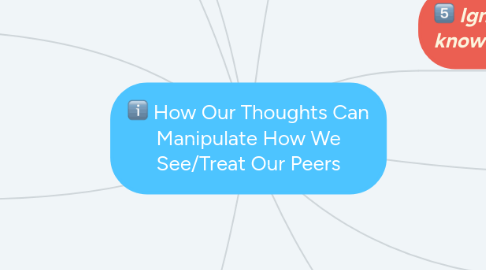
1. Racism
2. Elaboration/Corresponding Thoughts: A mindset that reinforces a belief that a specific race is inferior to your own along with having some form of spite towards the specific race ("Stamped" and the story of racism in the U.S.)
2.1. Corresponding Actions: Systemic Racism, Racial Discriminations, Police Brutality, Job Discrimination, etc.
3. Stereotypes
3.1. Elaboration: Grouping all individuals who hold similar traits together as if they are the same (Stereotypes Examples: 5 Common Types).
3.1.1. Corresponding Thoughts: Believing that all men are, emotionless, meant to do all of the work, dominant, etc.
3.1.1.1. Corresponding Action: Discrediting how masculine a man is based on the lack of traits that he shares with society's expectation of the typical man.
4. In-group Biases
4.1. Elaboration/Corresponding Thoughts: favoring individuals who shares similarities to your identity(s) while rejecting those who don't (American Psychological Association).
4.1.1. Corresponding Actions: Be-friending others who believes in the same religion as you while downgrading or discrediting the religion that other's believe in because it differs from yours.
5. ~In conclusion~ It is impossible to put human beings into a box. We all bring something different to the table despite what we identify with. We are doing ourselves a disservice by having expectations on individuals before we even get to know them. By educating ourselves and entering situations with an open-mind, this could limit the amount of hatred and division we see in the world and which can allow us to come together more as humans beings.
6. Implicit Biases
6.1. Elaboration/Definition: "Implicit Biases are basically thought processes that happen without you even knowing it" (Implicit Bias: Peanut Butter, Jelly, and Racism).
6.1.1. Corresponding (Subliminal) Thoughts: Believing that darker skinned individuals are more prone to being "dangerous" than fair skinned individuals.
6.1.1.1. Corresponding (Subliminal) Actions: A woman clutching or holding her purse closer to her when she comes within close contact with a darker skinned individual
7. Ignorance and/or lack of knowledge about a group
7.1. Elaboration: Sometimes we reframe from controversial conversations about politics, ethnicity, and personal pronouns that reinforces our lack of knowledge about those groups we don't know much about. Without the knowledge, this encourages individuals to come up with their own assumptions that can influence how they treat individuals from those groups. (On "Difficult" Conversations)
7.1.1. Corresponding Thoughts: Not knowing much about an opposing political party but, you know that this political party supports some actions that you don't believe in.
7.1.1.1. Corresponding Actions: Discrediting individuals who are on the opposing political party without having a conversation with them as to why they support their political party of choice .
